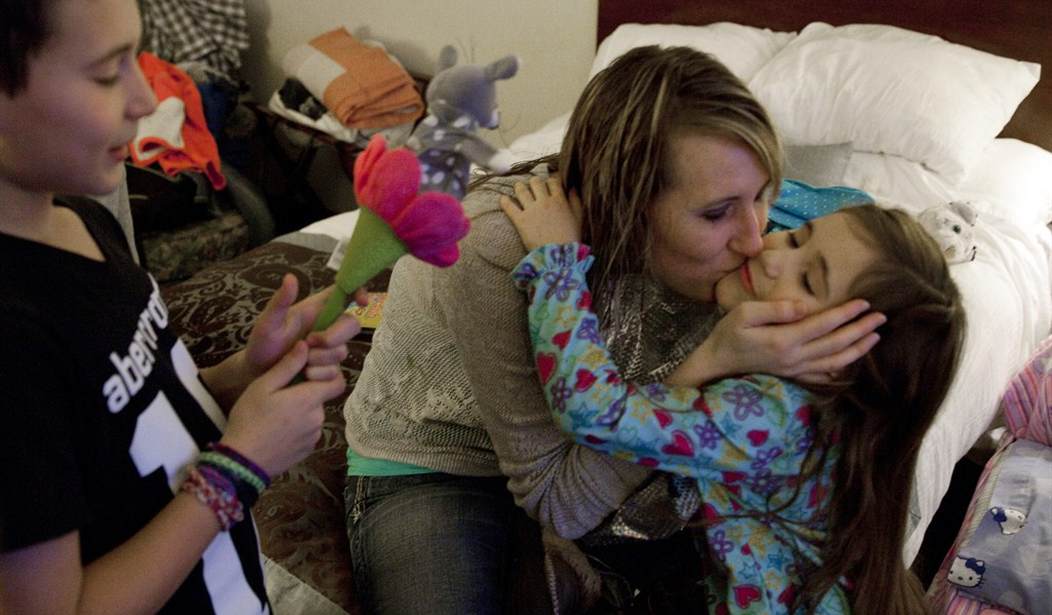It's a subject that many people are uncomfortable with. "Everyone either is or knows and has a deep personal connection to someone who is divorced, cohabiting, or gay," Schulz writes. "Great numbers of people simply want to avoid awkward talk of what are seen as primarily personal issues or issues of individual morality."
Nonetheless, it is an uncomfortable truth that children of divorce and children with unmarried parents tend to do much worse in life than children of two-parent families. (I'll leave aside the sensitive issue of children of same-sex marriages, since these haven't existed in a non-stigmatized atmosphere long enough to produce measurable results.)
As Schulz points out, that uncomfortable truth is not controversial among social scientists. It is affirmed by undoubted liberals such as Harvard's David Ellwood and Christopher Jencks.
Growing up outside a two-parent family means not just lower incomes and less social mobility, Schulz argues. It also reduces human capital -- "the knowledge, education, habits, willpower -- all the internal stuff that is largely intangible a person has that helps produce an income."
Recommended
While children are born with certain innate capacities, those capacities can be broadened or narrowed by their upbringing. The numbers indicate that single or divorced parents -- however caring and dedicated -- are unable, on average, to broaden those capacities as much as married parents can.
These differences have sharp implications for upward mobility. Schulz points to an Economic Mobility Project analysis showing that, among children who start off in the bottom third of the income distribution, only 26 percent with divorced parents move up, compared to 42 percent born to unmarried mothers (who may marry later, of course) and 50 percent who grow up with two married parents.
All this matters more than it used to because two-parent families are much more uncommon than they used to be. In 1960 about three-fourths of Americans 18 and over were married. In 2011, less than half were.
One reason is that people are getting married later in life. Back in 1959, one of the last years of the Baby Boom, most American women got married before they turned 21.
In the last half-century, the age of first marriage has crept upward. In 1970, only 11 percent of men and 7 percent of women age 30 to 34 had never been married. In 2008, the corresponding figures were 37 percent of men and 28 percent of women.
In 1970, only 12 percent of Americans age 35 to 44 were unmarried. In 2009, 33 percent were.
Many see increased divorce as the explanation for this change. True, divorce rates spiked upward in the 1970s. But they peaked in the 1980s. Most of the change represents people not getting married at all.
In 1965, Daniel Patrick Moynihan, then-assistant labor secretary, won fame -- and vicious criticism -- for his report lamenting that 24 percent of black births were to unmarried mothers. By 2009, that rate had risen to 72 percent -- and the rate of unmarried births to all American mothers was 41 percent.
These changes have not affected all social classes uniformly. In his 2012 book "Coming Apart: The State of White America, 1960-2010," my AEI colleague Charles Murray showed that rates of divorce and single parenthood among college-educated whites, after increasing in the 1970s, are almost down to 1960s levels.
But among low-education, low-income whites, as well as blacks and Hispanics, family disintegration has become the norm.
Will these trends go on forever? Not necessarily. Schulz looks back to the 1950s, years of unusually high marriage rates. Go back further, to the years around 1900, and Americans were marrying later and larger percentages than today never married at all.
Increasing affluence and changing mores reinforced by universal media such as movies and television helped produce the midcentury America with well-nigh universal married parenthood.
People learn from experience. In surveys, children of divorce express disapproval of divorce -- and the decline in divorce rates since the 1980s suggests they divorce less often than their parents' generation.
So it's at least possible that those most familiar with the ill effects of family disintegration will choose in their own lives to take a different course.
























Join the conversation as a VIP Member